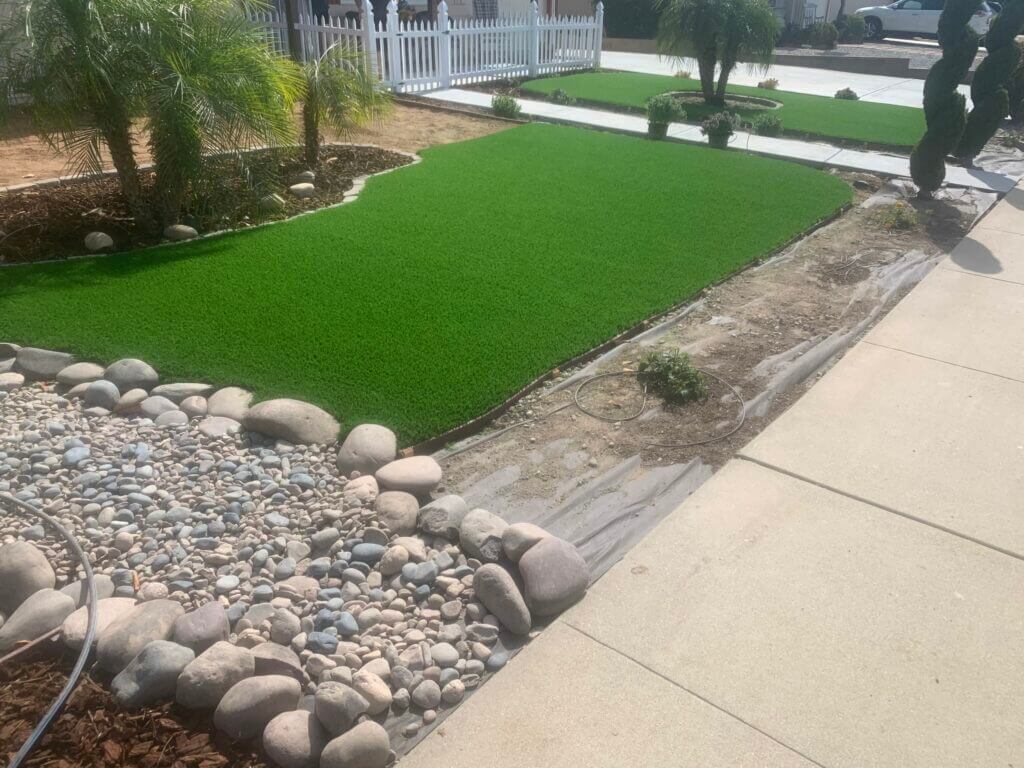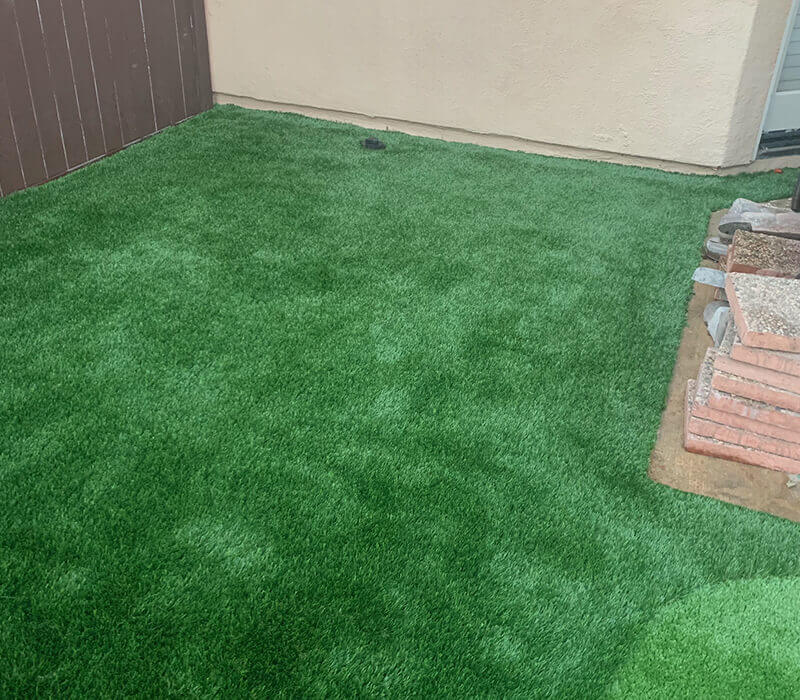Synthetic grass maintenance is crucial to keep your artificial lawn looking its best. Regularly removing leaves and debris, applying weed killer, brushing, and removing pet waste will help to keep your synthetic grass looking clean, healthy, and beautiful. It is also essential to avoid mirrors and other reflective surfaces, as they can cause intense heat to be reflected onto the synthetic grass fibers and cause damage. By following these tips, you can ensure that your synthetic grass lasts for a long time and looks great for many years.
Regularly remove leaves and debris
Regularly removing leaves and debris from your synthetic grass is an essential aspect of maintaining its appearance. Leaves and debris can accumulate on your artificial lawn and cause mold and mildew to grow, which can discolor and damage the grass. Keeping your synthetic grass clean is crucial to ensure that it lasts for a long time, and it is one of the most basic yet essential tasks to keep your artificial lawn looking great.
The accumulation of leaves and debris can also harbor pests and insects, harming the lawn. Thus removing them regularly can help keep the lawn free of these nuisances. One of the best ways to remove leaves and debris is to use a leaf blower. This tool can quickly and easily blow leaves and debris off the lawn, leaving it clean and tidy. Rakes and brooms can also be used but are not as efficient as a leaf blower.
Another way to remove leaves and debris is to use a lawn sweeper. This tool is designed to pick up leaves and debris from your lawn and store them in a collection bag. The advantage of using a lawn sweeper is that it is less labor-intensive than using a rake or broom, and it can be used to clean large areas of your lawn quickly and easily. Regularly removing leaves and debris is especially important during the fall when leaves are falling. You should clean your synthetic lawn at least once a week during this time or more frequently if necessary.

Apply weed killer
Applying weed killer is essential to synthetic grass maintenance, as it helps keep your artificial lawn free of weeds. Weeds can not only detract from the appearance of your lawn, but they can also cause damage to synthetic grass fibers. Weeds can grow between the fibers and cause them to shift and pull apart, making the lawn look patchy and uneven. A few different types of weed killers can be used on synthetic grass.
One of the most popular options is a post-emergent herbicide applied to the lawn after the weeds have already grown. These herbicides penetrate the weeds’ leaves and kill them at the roots. They can be used on a variety of different weeds and are generally considered to be safe for use on synthetic grass.
Another option is a pre-emergent herbicide applied to the lawn before the weeds have grown. These herbicides work by creating a barrier that prevents weed seeds from germinating. They can be used to prevent a variety of different weeds from growing on your synthetic grass, and they are generally considered safe for use on synthetic grass.
Applying weed killer is essential to synthetic grass maintenance, as it helps keep your artificial lawn free of weeds. It is essential to follow the manufacturer’s instructions carefully when applying them. By keeping your synthetic lawn free of weeds, you can ensure it looks great for many years. Furthermore, by being mindful of the environment and the health of the people and pets, you can ensure that the lawn is safe for everyone to enjoy.
Brushing
Brushing synthetic grass is essential to maintaining its appearance, as it helps keep the grass fibers standing upright and looking natural. The synthetic grass fibers can become matted over time, especially in high-traffic areas, making the lawn look flat and unnatural. Brushing the fibers back into place can help to restore the natural look and feel of your synthetic grass. A few different tools can be used to brush synthetic grass. One of the most popular options is a stiff-bristled brush. This type of brush is designed to lift and fluff the fibers of the grass, which can help to make the lawn look more natural. A stiff-bristled brush is also excellent for removing debris and dirt from the lawn.
Another option is a power brush. This brush is powered by electricity and is designed to quickly and easily brush large synthetic grass areas. Power brushes can be used to remove debris, dirt, and matted-down fibers from the lawn, and they can be a great time-saving option for those with more extensive lawns. When brushing synthetic grass, working in sections, starting at one end of the lawn and working your way to the other, is important. This will help ensure you don’t miss any lawn areas. Brushing in different directions is also important to ensure that all fibers stand upright. This will also help to redistribute the infill materials if your synthetic grass has it. You should brush your synthetic grass at least once a month or more frequently if necessary. By keeping on top of this task, you can ensure that your synthetic grass looks great for many years.
Remove pet waste
Removing pet waste from your synthetic grass is essential to maintaining its appearance and preventing odors. Pet waste can discolor the grass fibers and create an unpleasant smell if not removed promptly. Additionally, pet waste can harbor harmful bacteria and parasites, which can be dangerous for pets and humans. To remove pet waste from your synthetic grass, it is important to use a pet waste scooper or a plastic bag to pick up the waste. Once the waste has been removed, the area should be cleaned with water and a mild detergent to remove any remaining bacteria and odors. Doing this as soon as possible after the pet has relieved itself is recommended.
It is important to note that some pets may react to synthetic grass. This is especially common in cats that may find the artificial turf less appealing than natural grass and avoid using it. It is also essential to train your pets to use designated areas of synthetic grass for elimination. This will help to keep the rest of the lawn clean and reduce the amount of pet waste that needs to be removed.
In addition to regularly cleaning up pet waste, it’s also essential to use a deodorizer to neutralize any lingering odors. You can use a commercial deodorizer or make your own with water and white vinegar. It is important to note that some pets may react to synthetic grass. This is especially common in cats that may find the artificial turf less appealing than natural grass and avoid using it.
Avoid mirrors and other reflective surfaces
Avoiding mirrors and other reflective surfaces on your synthetic grass is important to maintaining its appearance and preventing damage. Mirrors and other reflective surfaces can cause intense heat to be reflected on the synthetic grass, which can cause the fibers to melt or become discolored. This can result in unsightly patches on your lawn and shorten your synthetic grass’s lifespan.
To prevent damage from mirrors and other reflective surfaces, keeping them away from your synthetic grass is important. This means not placing mirrors or other reflective surfaces on or near your synthetic grass. If you have a nearby window that reflects sunlight onto the lawn, it’s recommended to use blinds or curtains to block the sunlight during the hottest hours of the day.
For example, if you have a nearby window that reflects sunlight onto the lawn during the hottest hours of the day, it’s recommended to use blinds or curtains to block the sunlight. If your synthetic grass is located near a BBQ or outdoor fireplace, it’s important to keep them a safe distance away to prevent heat damage. It’s also important to be mindful of the reflection on the water if you have a pool or other water feature and to take the necessary precautions to avoid it.

Conclusion
Synthetic grass maintenance is essential to keep your artificial lawn looking its best. Regularly removing leaves and debris, applying weed killer, brushing, and removing pet waste ensure that your synthetic grass stays in excellent condition. It’s essential to avoid placing mirrors and other reflective surfaces on your synthetic grass. By following these tips, you can enjoy a beautiful, low-maintenance synthetic lawn for years to come. Regular maintenance is key to extending the lifespan of your artificial lawn, and by taking a proactive approach, you can ensure that your synthetic grass looks its best. At Ruff N Tuff Turf, taking care of your artificial lawn is key to ensuring a long-lasting and pleasurable experience. We offer a variety of services designed to help you keep your synthetic turf looking its best, including regular maintenance in Irvine, CA.
The post Synthetic Grass Maintenance: Tips to Keep Your Artificial Lawn Looking its Best appeared first on Ruff n Tuff Turf.

